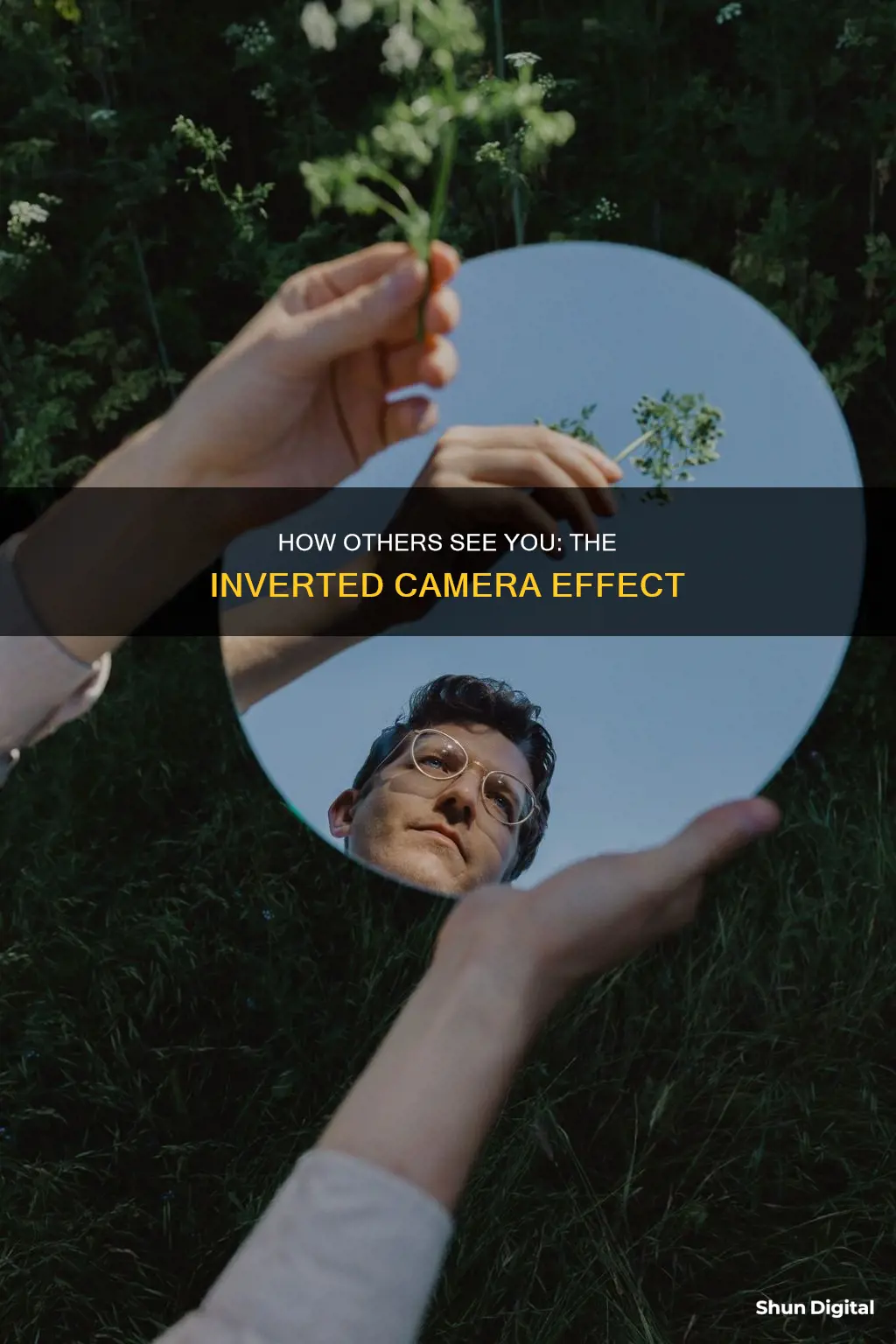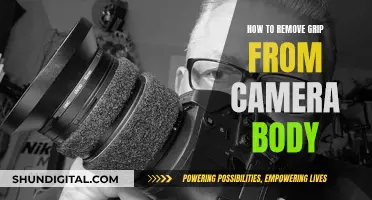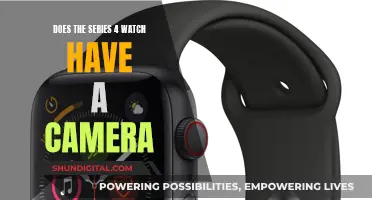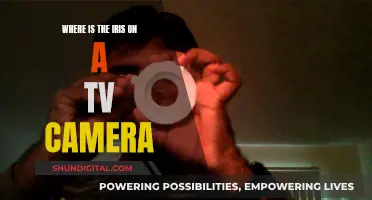
The inverted filter on TikTok has sparked conversations about self-perception and how we appear to others. When you look in a mirror, you see a reversed image of yourself, but in real life, people see your unflipped image. This discrepancy has led to the popularity of the inverted filter, which flips your image horizontally, creating a mirror-like effect. While some find it intriguing, others have reported negative reactions, highlighting the potential impact of social media on self-esteem and body image. The mere exposure effect suggests we like things we see frequently, so it's natural to prefer your mirror image. However, mirrors and photos can distort your reflection, and factors like lighting and angles can also affect how you perceive yourself.
| Characteristics | Values |
|---|---|
| What people see in a mirror | A reversed image of themselves |
| What a camera shows | An unflipped image, or the opposite of a mirror reflection |
| Which is more accurate, a mirror or a photo? | A mirror is generally more accurate as it is less susceptible to distortion and provides a 3-D view |
| How to see your true image in a mirror | Place two mirrors together at a right angle |
| Why do people prefer their mirror image? | They are more familiar with it due to seeing it every day |
| Why do people look different in photos? | Cameras are affected by factors such as quality, lens size, and angle |
What You'll Learn
- The inverted filter is not literal—phones can warp your image
- People see your image un-flipped in real life, not like in the mirror
- Mirrors are generally more accurate than photos as they are less susceptible to distortion
- You tend to like your mirror image better as you're more familiar with it
- You can see your inverted image in a mirror by placing two mirrors together at a right angle

The inverted filter is not literal—phones can warp your image
The inverted filter on TikTok has sparked a lot of interest and discussion, with many people wondering if it truly shows how others see them. While the filter does flip your image horizontally, creating a mirror-like effect, it's important to remember that it is not a literal representation of how you appear to others. The way you look can be warped by various factors, including your phone model, lens quality, and lighting conditions.
Phone cameras can distort your image due to differences in lens quality, clarity, and other factors unique to each device. This means that even if two people take a photo of the same person, the images may turn out differently because of the phones they used. It's important to be cautious of this and not get too caught up in the trends on social media platforms like TikTok, which can sometimes promote body-shaming or beauty-checking.
If you want a more objective view of how you look to others, it is recommended to look at your reflection in a large piece of glass, such as the side of a building. Building glass tends to have a standard reflective sheen designed to reflect sunlight and is not created for beauty enhancement, so it can provide a more accurate and unbiased view of your appearance.
Additionally, mirrors can also affect how you look due to their construction and lighting. Some mirrors may warp your reflection, making you appear thinner or altering certain features. So, while mirrors provide a more dynamic and accurate reflection than photos, not all mirrors are created equal, and external factors can still influence your reflection.
It's important to remember that everyone has unique facial features and asymmetries, and that's completely normal. Don't let a social media filter or a distorted image on your phone define your self-worth or perception of your appearance.
Viewing Foscam Cameras on Windows: A Simple Guide
You may want to see also

People see your image un-flipped in real life, not like in the mirror
When you look at yourself in a mirror, you are seeing a reversed image of yourself. This is how you are used to seeing yourself, and so it can be surprising to see your image flipped, either in a photo or with TikTok's inverted filter. However, this flipped image is how other people see you in real life. So, when you are hanging out with friends or walking down the street, the features that you are used to seeing on one side of your face actually appear on the opposite side to others.
It is common to prefer your mirror image, as this is the version of yourself that you are most familiar with. Your un-flipped image can seem strange in pictures and filters. This is because we tend to like things that we see frequently or regularly. Research has shown that most people prefer how they appear in a mirror, but their partner and friends like how they look in regular, un-flipped photos more.
If you want to see yourself as others see you, you can place two mirrors together at a right angle. Angle each mirror diagonally towards you so that their edges form a right angle. Now, when you close your right eye, your reflection will too, but it will look like your left eye is closed!
Understanding Camera Vision in Unity: What's in View?
You may want to see also

Mirrors are generally more accurate than photos as they are less susceptible to distortion
On the other hand, mirrors simply reflect your image back to you. While the angle and distance from the mirror can distort your perception, mirrors are generally less affected by outside factors. They provide a 3-D view of yourself in motion, allowing you to see yourself as others see you in a dynamic and more accurate way.
The two primary types of mirrors, flat and curved, are worth considering when discussing mirror accuracy. Flat mirrors show a version of yourself with left and right sides reversed, while curved mirrors introduce slight distortions, making your image appear compressed or elongated. Despite these differences, mirrors are generally less susceptible to distortion than cameras.
Additionally, the familiarity effect also comes into play. We are used to seeing our mirror image daily, making us feel more comfortable and perceiving it as more attractive. This familiarity influences our preference for mirror images over camera images, even if the mirror image is not entirely accurate.
In conclusion, while neither flat mirrors nor cameras show us exactly how we look, mirrors are generally more accurate than photos as they are less susceptible to distortion and provide a dynamic, 3-D view of ourselves as others see us.
Viewing 8mm Tapes: Alternative Methods Without a Camera
You may want to see also

You tend to like your mirror image better as you're more familiar with it
It's natural to prefer your mirror image, as this is the version of yourself that you're most familiar with. You've spent your life seeing your face in the mirror, so you've grown accustomed to this specific view. This phenomenon is known as the ""mere-exposure" effect, a psychological concept that suggests people react favourably to things they're most familiar with.
When you see your face in reverse, it can feel jarring and uncomfortable because it doesn't match your established impression of yourself. This is especially true if you have features that are unique to one side of your face, such as a mole, scar, or a particular hairstyle. These features are typically reversed in photos, making your face appear "wrong" compared to your expectations.
It's important to remember that neither mirrors nor photos capture the "true" you. Mirrors show a reversed image, while photos can be affected by factors like angles, lighting, and lens distortion. In reality, the way you present yourself to the world is a combination of your mirror and camera image, and both are valid representations.
Interestingly, research has shown that people tend to prefer the mirror image of others as well, not just themselves. This further highlights the power of familiarity in shaping our preferences and perceptions.
In summary, it's completely normal to like your mirror image better simply because it's what you're used to seeing. This doesn't mean that you look worse or weird in real life; it's just a result of the human tendency to favour familiarity.
Wiring Swann Cameras Directly to Your TV: A Step-by-Step Guide
You may want to see also

You can see your inverted image in a mirror by placing two mirrors together at a right angle
To see your inverted image in a mirror, you can place two mirrors together at a right angle. This means angling two mirrors so that their edges touch and form a right angle, like you're holding a book.
This method works because, while one mirror reverses your image, the second mirror flips the reversed image back, showing your "true" image.
Using MacBook Camera: How to View Yourself
You may want to see also
Frequently asked questions
Yes, an inverted camera is how people see you in real life. When you look in a mirror, the image is actually reversed, so the left side of your face is on the right, and vice versa.
You look different because you're more familiar with your mirror image. Your brain expects to see your features reversed, so when you see your flipped image, it can seem uncanny and highlight the asymmetry of your face.
Your mirror image is generally more accurate than a photo. Mirrors are less susceptible to distortion and provide a dynamic 3D view of yourself in motion, which is how others see you.
You may look strange in photos due to camera distortions. Factors such as lighting, angle, lens size, and quality can all affect how your image comes out.
You can place two mirrors together at a right angle to see your un-reversed image. This will show you how others see you, with your features on the correct sides.







